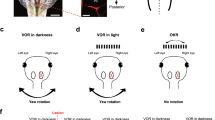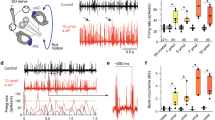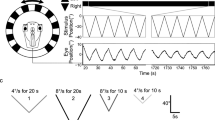Summary
The static vestibulo-ocular reflex was investigated in tadpoles at different times following unilateral destruction of the labyrinth during the period of early organogenesis and premetamorphosis. Balance compensation is completed after a few weeks, while gain compensation only occurs partially (Figs. 2–4). Tadpoles hemilabyrinthectomized in the age of 2.5 days (stage 38) develop no vestibular nuclei on their lesioned side, while tadpoles operated later in their life, possess these nuclei (Figs. 5, 6) even if they were not detectable at the operation day (Fig. 7). For their dorsal vestibular nucleus (DVN), the number of neurons is usually larger on the intact than on the lesioned side; while for the ventral vestibular nucleus (VVN), there is either numerical symmetry or a transient decrease of cell number on the intact side (Fig. 5).
The results demonstrate that vestibular compensation occurs even if vestibular nuclei have developed only on one side, i.e. the vestibular commissure is not a prerequisite for a successful compensation process. It is discussed whether the use of extra-vestibular error signals for balance but not for gain compensation may cause the differences in time courses of both compensation processes.
Similar content being viewed by others
Abbreviations
- α :
-
eye angle
- γ :
-
roll angle
- α(γ) :
-
response characteristic
- A :
-
response amplitude
- G :
-
response gain
- VOR :
-
vestibuloocular reflex
- VVN :
-
ventral vestibular nucleus
- DVN :
-
dorsal vestibular nucleus
References
Agosti R, Dieringer N, Precht W (1986) Partial restitution of lesion-induced deficits in the horizontal vestibulo-ocular reflex performance measured from the bilateral abducens motor output in frogs. Exp Brain Res 61:291–302
Bienhold H, Flohr H (1978) Role of commissural connections between vestibular nuclei in compensation following unilateral labyrinthectomy. J Physiol (Lond) 284:178
Blanks RHI, Precht W, Giretti ML (1977) Response characteristics and vestibular receptor convergence of frog cerebellar Purkinje cells. A natural stimulation study. Exp Brain Res 27:181–201
Cohen B (1974) The vestibulo-ocular reflex arc. In: Kornhuber HH (ed) The vestibular system. Part 1: Basic mechanisms. (Handbook of sensory physiology, vol VI/1) Springer, Berlin Heidelberg New York, pp 477–540
Dieringer N, Precht W (1979a) Mechanisms of compensation for vestibular deficits in the frog. I. Modification of the excitatory commissural system. Exp Brain Res 36:311–328
Dieringer N, Precht W (1979b) Mechanisms of compensation for vestibular deficits in the frog. II. Modification of the inhibitory pathways. Exp Brain Res 36:329–341
Flohr H, Bienhold H, Abeln W, Macskovics I (1981) Concepts of vestibular compensation. In: Flohr H, Precht W (eds) Lesion-induced neuronal plasticity in sensorimotor systems. Springer, Berlin Heidelberg New York, pp 153–172
Föller W, Horn E (1986) Functional regeneration of the cereal gravity receptor of crickets,Gryllus bimaculatus. Verb Dtsch Zool Ges 79
Galiana HL, Flohr H, Melvill Jones G (1984) A reevaluation of intervestibular nuclear coupling: its role in vestibular compensation. J Neurophysiol 51:242–259
Hess BJM, Knöpfel T, Precht W (1984) Dynamics of maculoocular reflexes in the frog. Neuroscience 11:645–650
Horn E, Rayer B (1978) Compensation of vestibular lesions in relation to development. Naturwissenschaften 65:441
Horn E, Lang HG, Rayer B (1986a) The development of the static vestibulo-ocular reflex in the Southern Clawed Toad,Xenopus laevis. I. Intact animals. J Comp Physiol A 159:869–878
Horn E, Mack R, Lang HG (1986b) The development of the static vestibulo-ocular reflex in the Southern Clawed Toad,Xenopus laevis. II. Animals with acute vestibular lesions. J Comp Physiol A 159:879–885
Kidokoro M (1968) Direct inhibitory innervation of teleost oculomotor neurones by cerebellar Purkinje cells. Brain Res 10:453–456
Knöpfel T, Hess BJM, Precht W (1984) Responses of frog trochlear motoneurons to linear acceleration. J Comp Physiol A 154:233–240
Llinás R (1976) Cerebellar physiology. In: Llinás R, Precht W (eds) Frog neurobiology. Springer, Berlin Heidelberg New York, pp 892–923
Maioli C, Precht W, Ried S (1983) Short- and long-term modifications of vestibulo-ocular response dynamics following unilateral vestibular nerve lesions in the cat. Exp Brain Res 50:259–274
Nieuwkoop PD, Faber J (1975) Normal table ofXenopus laevis (Daudin). Hubrecht Laboratory, Utrecht
Paterson NF (1948) The development of the inner ear ofXenopus laevis. Zool Soc (Lond) 119:269–291
Precht W (1976) Physiology of the peripheral and central vestibular system. In: Llinás R, Precht W (eds) Frog neurobiology. Springer, Berlin Heidelberg New York, pp 481–512
Precht W, Richter A, Ozawa S, Shimazu H (1974) Intracellular study of frog's vestibular neurons in relation to the labyrinth and spinal cord. Exp Brain Res 19:377–393
Rayer B, Cagol E, Horn E (1983) Compensation of vestibular induced deficits in relation to the development of the Southern Clawed Toad,Xenopus laevis Daudin. J Comp Physiol 151:487–498
Romeis B (1968) Mikroskopische Technik. Oldenburg, München Wien
Sachs L (1974) Angewandte Statistik. Springer, Berlin Heidelberg New York
Schaefer KP, Meyer DL (1973) Compensatory mechanisms following labyrinthine lesion in the guinea-pig. A simple model of learning. In: Zippel HP (ed) Memory and transfer of information. Plenum Press, New York, pp 203–232
Schaefer KP, Meyer DL (1974) Compensation of vestibular lesions. In: Kornhuber HH (ed) Vestibular system, part 2, Psychophysics, applied aspects and general interpretations. (Handbook of sensory physiology, vol VI/2) Springer, Berlin Heidelberg New York, pp 463–491
Sotelo C (1976) Morphology of cerebellar cortex. In: Llinás R, Precht W (eds) Frog neurobiology. Springer, Berlin Heidelberg New York, pp 864–891
Wallman J, Velez J, Weinstein B, Green AE (1982) Avian vestibuloocular reflex: adaptive plasticity and developmental changes. J Neurophysiol 48:952–967
Will U, Luhede G, Görner P (1985a) The area octavo-lateralis inXenopus laevis. I. The primary afferent projections. Cell Tissue Res 239:147–161
Will U, Luhede G, Görner P (1985b) The area octavo-lateralis inXenopus laevis. II. Second order projections and cytoarchitecture. Cell Tissue Res 239:163–175
Windle WF (1970) Development of neural elements in human embryos of four to seven weeks gestation. Exp Neurol [Suppl] 5:44–83
Author information
Authors and Affiliations
Rights and permissions
About this article
Cite this article
Rayer, B., Horn, E. The development of the static vestibulo-ocular reflex in the Southern Clawed Toad,Xenopus laevis . J. Comp. Physiol. 159, 887–895 (1986). https://doi.org/10.1007/BF00603742
Accepted:
Issue Date:
DOI: https://doi.org/10.1007/BF00603742




